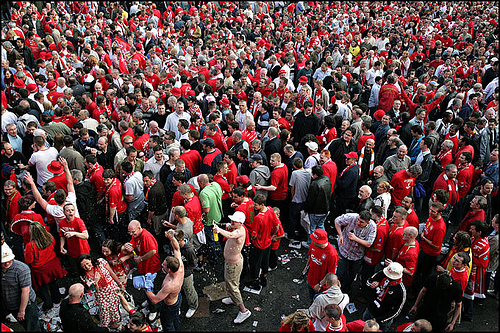While large crowds tend to move in an innately disordered, unreasonable manner, there are methods for determining the actions of large groups of people, and we mustn’t look too far to see why this problem demands attention. In various countries, no matter the sporting event, there are riots, crowd crushes, and stampedes that occur every year. Unfortunately, these accidents are not wholly preventable, but there are preemptive measures that can be taken, and examining theories behind crowd mentality and movement are a good place to start.
Dr Brian Hughes, a biological psychologist at National University of Ireland (NUI) Galway, said that “one gets a superficial sense of solidarity and well being when present in a crowd. But it can also lead to the individual’s diffusion of responsibility. We are less conscientious. Individuals tend to leave things to other people.”
Speaking on European soccer matches, Dr. Hughes said that “the level of rivalry felt by opposing fans is partly due to a perceived sense of immortality that being part of a club brings. There was a legacy there before you and it will be there after you. So it’s about outlasting your own lifetime. This makes people personally reckless.”
Hughes believes that people leave tasks to other people when they are in a group, and likened it to a group of people passing a homeless person on the streets. He said one is more likely to give the homeless person money if they are alone.
Researchers at the University of Limerick (UL) also did a study on the psychological connections to crowd theory. They found that those who actively engage with the perceived “enemy” will enjoy positive psychological benefits. Professor Orla Muldoon of the UL Department of Psychology explained that people change the way they behave when they know others are watching them, and used bar karaoke as an example of this.
Muldoon also related the drive theory of facilitation which states that some people are able to perform better when surrounded by a large crowd, while others (most people), are only able to perform the simplest of tasks, and as a result, are very reactive in those situations.
Professor Muldoon and Dr. Hughes both believe, as we’ve stated in the past, that any atmosphere which communicates a lack of control leads to anxiety, then panic – and this is how riots escalate. Dr. Hughes asserts that this is why sporting stadiums began numbering their seats, and believes this wasn’t always the case.
In regards to science, many physicists apply the models they use to study the movement of particles, to studying the movement of people in a crowd.
For instance, particles move in lanes unless they encounter some sort of obstacle. Humans are the same. Even on a busy street, we see people walking in lanes – those walking east, those walking west, etc. If there is an obstacle in the street, such as someone stopped to tie their shoes, the flow of the lane is interrupted and a number of other obstructions may occur as a result.
For this reason, stadiums should be sure to leave their walkways wide and clear. Signage and directionals that are easy to read will assure that the crowd is moving in a safe manner, and queuing equipment that keeps people constantly moving will contribute to a safer, more controlled flow among large crowds.
Many of the quotes featured in this post were taken from an article featured in the Irish Times titled “Far from the Madding Crowd.” It is a great article that relates crowd theories to soccer in Ireland, and it helps reinforce all of the things we’ve been blogging about for two years now.


